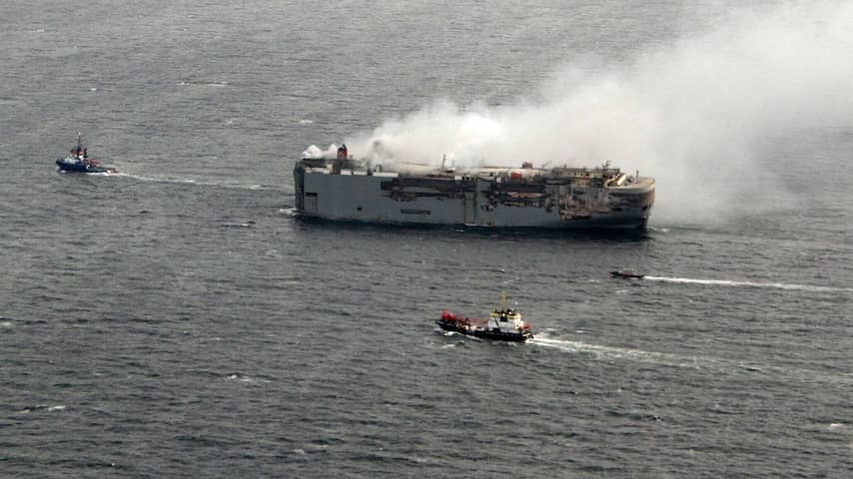
During the fire on the cargo ship Fremantle Highway, it took too long for the coast guard to get an idea of the extent of the disaster. The rescue operation therefore started later than necessary, according to a report by the Dutch Safety Board.
On July 25, 2023, a fire broke out on the Fremantle Highway around 11:00 PM. The ship was then sailing on the North Sea, about 27 kilometers above Ameland. The Fremantle Highway transported more than 3,700 cars, most of which were lost.
At 11:55 PM, the captain of the ship first asked for help, initially to extinguish the fire. The fire spread within a few hours and the 23 crew members had to be rescued. Seven crew members jumped overboard from a great height. They sustained serious injuries. One of them died after the fall.
The crew members jumped overboard because there were no rescue helicopters at the ship yet. The coast guard took too long to consider the scenario of extinguishing the fire and started a rescue operation too late. This is the conclusion of the Dutch Safety Board (OVV), which investigated the rescue operation.
Communication between the coast guard and other parties did not run smoothly, which meant that not all information was shared with each other. The OVV therefore concludes that emergency assistance in the event of an incident at sea is vulnerable. The council advises the three ministries involved (Defense, Justice and Security, and Infrastructure and Water Management) to improve the procedures as quickly as possible.
Helicopters Considered Extingughing for A Long Time
The poor communication meant, among other things, that extinguishing helicopters were in the wrong place for too long. The Coast Guard Center had sent two helicopters to Rotterdam to pick up a specialized fire brigade team for ship fires (MIRG).
Because the fire brigade team waited a long time for additional information, the helicopters remained in Rotterdam for an hour. The team wanted to know more about the situation on the ship so that it could decide whether its deployment was effective and safe.
The Coast Guard Center also had difficulty getting a picture of the extent of the fire. At 2:00 AM, the coast guard plane was on site. The thermal imaging camera of the plane showed that the fire had spread over the entire ship. That was the moment the coast guard decided to switch to a rescue operation instead of firefighting.
The helicopters were eventually sent to the ships without the fire brigade team. There, the smoke development increased and the situation became increasingly critical. Around 2:30 AM, the crew indicated that they wanted to leave the ship. But it took another 45 minutes until the helicopters were at the ship. Due to the smoke, the lifeboats were not accessible.
Jumping Proved Too Dangerous
Therefore, it was agreed that the crew members would jump overboard one by one, with a few minutes in between each time. Two rescue boats from the KNRM and a rescue boat from shipping company Noordgat had reached the ship shortly before. They would take a crew member out of the water alternately.
One crew member jumped from a height of 12 meters. The remaining crew members were on the highest deck, 30 meters above sea level.
After six crew members had jumped, a skipper from the KNRM advised to stop doing so. The jumped crew members had sustained serious injuries. Shortly after that information was passed on, a seventh crew member jumped. The rest of the crew had to wait for the helicopters, which had to fly to the ship for another fifteen minutes at that time.
Gate of the airport was still closed
Communication with the safety region and the control room of the emergency services was also difficult. It was unclear for a long time where the rescue helicopters with the crew members would land. Groningen Airport Eelde was eventually chosen.
But the hospitals in Drenthe, where the airport is located, were only informed late that they had to receive the crew members. And the airport was also not informed on time: ambulances had to wait fifteen minutes before the gate was opened.